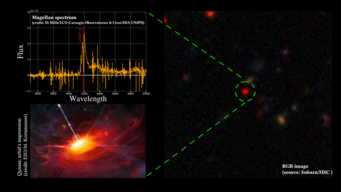Serendipitous detection of a rapidly accreting black hole in the early Universe
eROSITA telescope finds an X-ray bright, optically faint quasar accreting material at an extremely high rate only about 800 million years after the big bang
Analysing data from the eROSITA Final Equatorial-Depth Survey, astronomers at MPE have found a faint X-ray source identified with a very distant supermassive black hole that is accreting material at an extremely high rate. This quasar, at a redshift of z=6.56, is much more luminous in X-rays than expected. This is the most distant blind X-ray detection to date, from an object whose radiation was emitted almost 13 billion years ago and allows the scientists to investigate the growth of black holes in the early Universe.
Supermassive black holes at the centres of galaxies can be detected out to great distances – but only if they accrete matter, which heats up and shines brightly, causing it to become an “active galactic nucleus” (AGN). These “quasars” or quasi-stellar objects then outshine the rest of their galaxy, but at large distances, they nevertheless are difficult to detect and extremely rare. To date, only about 50 quasars with redshift z>5.7, when the Universe was less than one billion years old, have been detected in X-rays.

Analysing X-ray data of the eROSITA Final Equatorial-Depth Survey (eFEDS), which were taken during the Performance Verification Phase of the eROSITA telescope in 2019, the eROSITA team found a new point source. In collaboration with colleagues using the Subaru telescope, they identified the X-ray emission with a previously known quasar J0921+0007 at a redshift of 6.56, which was initially discovered by a team searching for distant sources with the Subaru telescope. Dedicated follow-up observations at infrared wavelengths showed that the black hole has 250 million solar masses, a relatively low mass for a supermassive black hole at this distance. Chandra follow-up observations confirmed the high X-ray luminosity measured by eROSITA, indicating a very high accretion rate.
“We did not expect to find such a low-mass AGN already in our very first mini-survey with eROSITA”, says Julien Wolf, who searches for the most distant supermassive black holes in eROSITA data as part of his Ph.D. at the Max Planck Institute for Extraterrestrial Physics (MPE). “It is the most distant serendipitous X-ray detection to date and its properties are rather atypical for quasars at such high redshifts: it is intrinsically faint in visible light but very luminous in X-rays.”
The quasar detected by eROSITA shows properties, which are similar to so-called narrow-line Seyfert-1 galaxies, a particular class of active galaxies in the local Universe. They are associated with supermassive black holes below 100 million solar masses, accreting matter at a high rate, and could be younger than their higher mass siblings.
“Hunting for rare objects like this needs deep multi-wavelength data complementing the large X-ray survey area. Luckily, most of the sky is mapped at optical and infrared wavelengths, although the Subaru data in eFEDS area are especially deep,” emphasises Mara Salvato, eROSITA spokesperson.

While the bulk of active galaxies detected at high redshifts (i.e. large distances) host black holes with masses of one to ten billion solar masses, there must also be many with less massive black holes. These, however, need to accrete matter at a very high rate to shine brightly enough so that they can be detected at all.
In addition to this source, the team had earlier found another luminous and similarly distant quasar in the same field. “eROSITA is uniquely suited to performing a census of rare X-ray objects like these powerful high-redshift quasars,” states Kirpal Nandra, director of high-energy physics at MPE. “This is now the second example we’ve found in eFEDS when we expected to find none”.
The early eROSITA data are just a foretaste of what’s to come. Based on these early detections, the scientists expect to find hundreds more examples with the eROSITA all-sky survey. In an effort to find this elusive population of yet unknown distant quasars, the group has developed a large programme exploring the eROSITA all-sky survey. This dedicated survey has already led to the discovery of five new X-ray luminous quasars at z>5.6, which will be presented in a future publication. Simultaneously, a Russian team of researchers have also reported the first eROSITA high-redshift detections in the northern hemisphere.
Objects like these are currently our best way of understanding early black hole formation. If the surprising eFEDS detections are confirmed in the larger dataset, it could represent a challenge for some evolutionary models.













